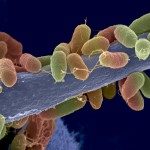Lien vers Pubmed [PMID] – 22408226
Eukaryotic Cell 2012 May;11(5):673-82
Dermatophytes are the most common cause of superficial mycoses in humans and animals. They can coexist with their hosts for many years without causing significant symptoms but also cause highly inflammatory diseases. To identify mechanisms involved in the modulation of the host response during infection caused by the zoophilic dermatophyte Arthroderma benhamiae, cell wall-associated surface proteins were studied. By two-dimensional gel electrophoresis, we found that a hydrophobin protein designated HypA was the dominant cell surface protein. HypA was also detected in the supernatant during the growth and conidiation of the fungus. The A. benhamiae genome harbors only a single hydrophobin gene, designated hypA. A hypA deletion mutant was generated, as was a complemented hypA mutant strain (hypA(C)). In contrast to the wild type and the complemented strain, the hypA deletion mutant exhibited “easily wettable” mycelia and conidia, indicating the loss of surface hydrophobicity of both morphotypes. Compared with the wild type, the hypA deletion mutant triggered an increased activation of human neutrophil granulocytes and dendritic cells, characterized by an increased release of the immune mediators interleukin-6 (IL-6), IL-8, IL-10, and tumor necrosis factor alpha (TNF-α). For the first time, we observed the formation of neutrophil extracellular traps against dermatophytes, whose level of formation was increased by the ΔhypA mutant compared with the wild type. Furthermore, conidia of the ΔhypA strain were killed more effectively by neutrophils. Our data suggest that the recognition of A. benhamiae by the cellular immune defense system is notably influenced by the presence of the surface rodlet layer formed by the hydrophobin HypA.

